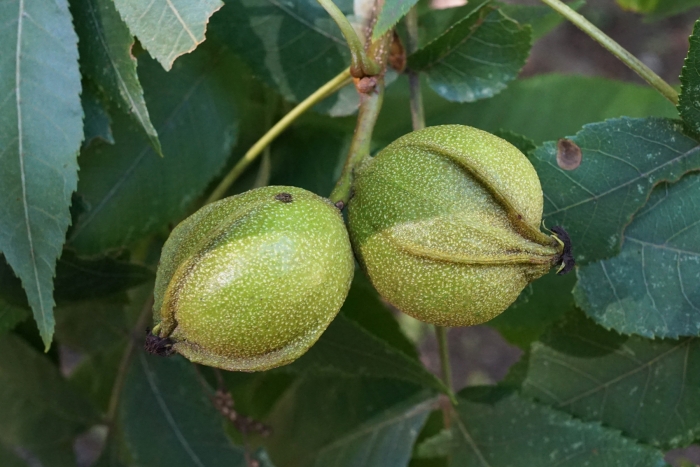Bitternut Hickory
(Carya cordiformis)
Bitternut Hickory (Carya cordiformis)
/
/

Plant Image Library from Boston, USA
CC BY-SA 2.0
Image By:
Plant Image Library from Boston, USA
Recorded By:
Copyright:
CC BY-SA 2.0
Copyright Notice:
Photo by: Plant Image Library from Boston, USA | License Type: CC BY-SA 2.0 | License URL: https://creativecommons.org/licenses/by-sa/2.0 | Uploader: Ser Amantio di Nicolao | Publisher: Wikimedia Commons | Title: Carya_cordiformis_(Bitternut_Hickory)_(37064132791).jpg | Notes: |





















































Estimated Native Range
Summary
Carya cordiformis, commonly known as Bitternut Hickory, is a deciduous tree native to moist bottomlands, floodplains, and along streams as well as drier upland sites in Eastern North America. It can grow up to 35 meters (115 feet) tall with a trunk diameter of up to 1 meter (3 feet 3 inches). The tree is characterized by its compound leaves, small wind-pollinated catkins produced in spring, and distinctive bright sulfur-yellow winter buds. The fruit is a very bitter nut, 2–3 cm (3⁄4–1+1⁄4 inches) long, encased in a green four-valved husk that splits open at maturity in the fall, revealing a hard, bony shell. Although related to the pecan and similar in leaf shape, Bitternut Hickory’s nuts are not edible.
Bitternut Hickory is valued for its hard, strong wood and is often harvested alongside other hickory species. It is the shortest-lived of the hickories, with a lifespan of about 200 years. This species is not commonly used in ornamental plantings due to its large size and the non-edible nature of its nuts, but it can be found in reforestation projects and naturalized areas. It thrives in full sun to part shade and is adaptable to various soil types, including those low in nutrients, with varying drainage capabilities. While it is not typically prone to serious pests or diseases, it can suffer from hickory bark beetle attacks. Bitternut Hickory is not known for being invasive when grown outside its native range.CC BY-SA 4.0
Bitternut Hickory is valued for its hard, strong wood and is often harvested alongside other hickory species. It is the shortest-lived of the hickories, with a lifespan of about 200 years. This species is not commonly used in ornamental plantings due to its large size and the non-edible nature of its nuts, but it can be found in reforestation projects and naturalized areas. It thrives in full sun to part shade and is adaptable to various soil types, including those low in nutrients, with varying drainage capabilities. While it is not typically prone to serious pests or diseases, it can suffer from hickory bark beetle attacks. Bitternut Hickory is not known for being invasive when grown outside its native range.CC BY-SA 4.0
Plant Description
- Plant Type: Tree
- Height: 50-80 feet
- Width: 30-50 feet
- Growth Rate: Moderate
- Flower Color: N/A
- Flowering Season: Spring
- Leaf Retention: Deciduous
Growth Requirements
- Sun: Full Sun, Part Shade
- Water: Medium
- Drainage: Fast, Medium, Slow
Common Uses
Bee Garden, Bird Garden, Butterfly Garden, Edible*Disclaimer: Easyscape's listed plant edibility is for informational use. Always verify the safety and proper identification of any plant before consumption.
Natural Habitat
Native to moist bottomlands, floodplains, and along streams as well as drier upland sites in Eastern North America
Other Names
Common Names: Swamp Hickory
Scientific Names: , Carya cordiformis, Juglans cordiformis, Carya minima, Carya amara, Hicoria minima, Carya cordiformis var. latifolia, Hicoria cordiformis, Hicorius minima, Carya cordiformis var. elongata
GBIF Accepted Name: Carya cordiformis (Wangenh.) C.Koch